Honeysuckle Hekroth - description and characteristics
Honeysuckle is one of the most unpretentious plants that can grow in almost all regions of our country. The most popular is the edible honeysuckle with healthy and tasty fruits. However, gardeners also grow an ornamental variety of this plant. Its berries are inedible, but they have an attractive appearance. One such crop is Hekroth's honeysuckle.
Absolutely all parts of this plant are decorative. These are reddish shoots, and green-blue leaves, and large bright flowers, and globular shiny red berries. What varieties of Hekroth's honeysuckle exist and how to grow them on your site - read on.
The content of the article
Honeysuckle varieties Hekroth
Honeysuckle Hekroth is curly decorative bush. It is a hybrid obtained by crossing evergreen and American honeysuckle. The Hekroth group includes several varieties.
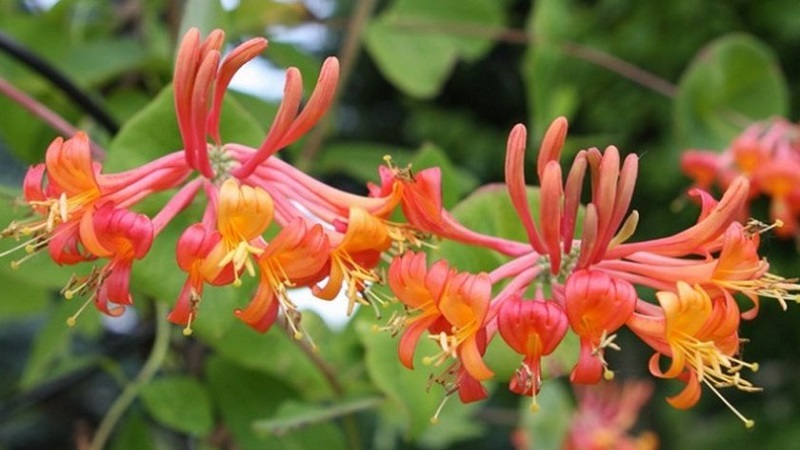
there is common characteristics that unite them:
- Bush... Tall, weaving. The branches are thin and flexible. Young shoots are reddish in color, with age they acquire a brown tint. Height of an adult plant on average it reaches 2-4 m (depending on the formation). Heckrot grows throughout life, increasing annually by 30-50 cm. The crown width varies within 2-4 m. The life of the shrub reaches 50 years.
- Leaves... Shirokoelepticheskogo form. In length they reach 8-10 cm. The color is green with a bluish tint. In autumn they acquire a yellowish tint.
- Flowers... Collected in large inflorescences. The length varies within 3-5 cm. Each flower has two petals, while the upper one is several times wider than the lower one and has a wavy edge. Flowers are two-tone, shades depend on the variety. Flowering lasts from June to September.
- Fruit... Round, shiny fruits. Poisonous. The diameter varies between 5-7 mm. The color depends on the variety.
Goldflame
Honeysuckle Hekrotta Goldflame (Lonicera Heckrottii) or Hekrotta Goldflame - one of the most popular varieties of climbing ornamental plants... Differs in high resistance to pests and diseases. This is a climbing vine.
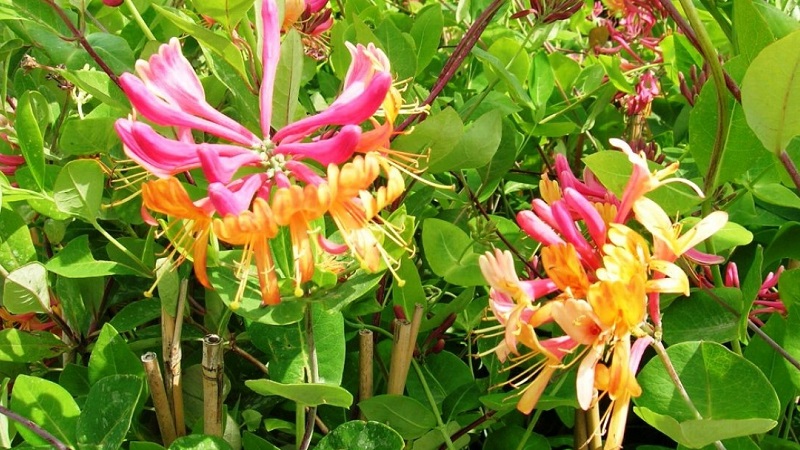
Leaves of a characteristic gray-green shade of the variety... They have jagged edges, up to 10 cm in length.
Bicolor flowers... The outside is bright pink and the inside is bright orange. Large (about 5 cm long). They have a strong sweetish aroma.
The berries are small, round, red... Ripen in late summer or autumn.
The variety has a number of advantages... Among them:
- a large number of foliage and flowers on the bush;
- a significant annual increase in the length of the shoots (more than 50 cm);
- long flowering;
- large flowers and inflorescences;
- the presence of immunity to infections and pests;
- fast rooting.
Frost resistance in Hecroth Goldflame honeysuckle medium... The plant is able to survive the winter in the central regions only under cover.
Hecrotta Goldflame has disadvantages too:
- poisonous fruits;
- exactingness to watering;
- exactingness to the composition of the soil;
- tendency to bare branches with age;
- long wait for the first flowering.
The first flowering and fruiting is expected in 3-4 years after the rooting of the plant.
American Beauty
Honeysuckle American beauty has characteristics that are slightly different from the previous variety... It is characterized by increased winter hardiness. It is a climbing shrub.
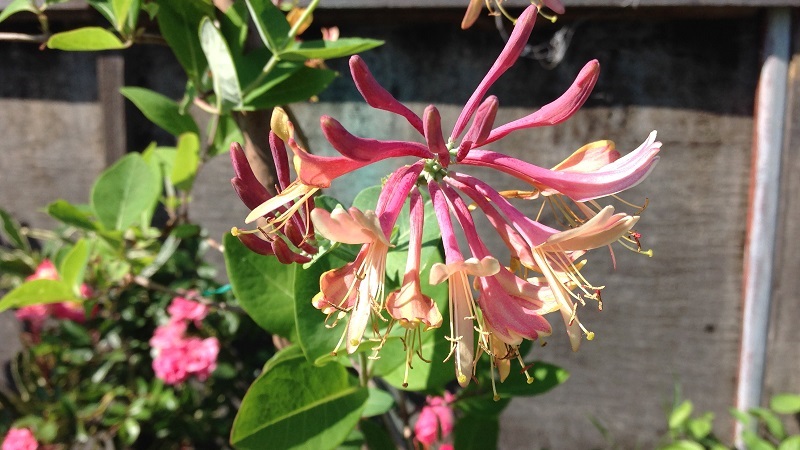
The flowers are creamy or pale yellow outside and pink inside... The inflorescences are more compact than that of the Goldflame honeysuckle. The upper petal of the flower is much wider than the lower one. The aroma is weak.
Berries are small, bright orange... Formed at the end of summer.
Benefits:
- high winter hardiness;
- abundant flowering and fruiting;
- large flowers (some specimens reach a length of 8 cm);
- fast rooting.
The main disadvantage is the exactingness of care.... The variety requires frequent watering and feeding.
Variegata
Honeysuckle Variegata (Variegata) outwardly differs significantly from other varieties of Hekrot... It looks decorative even when not in bloom.
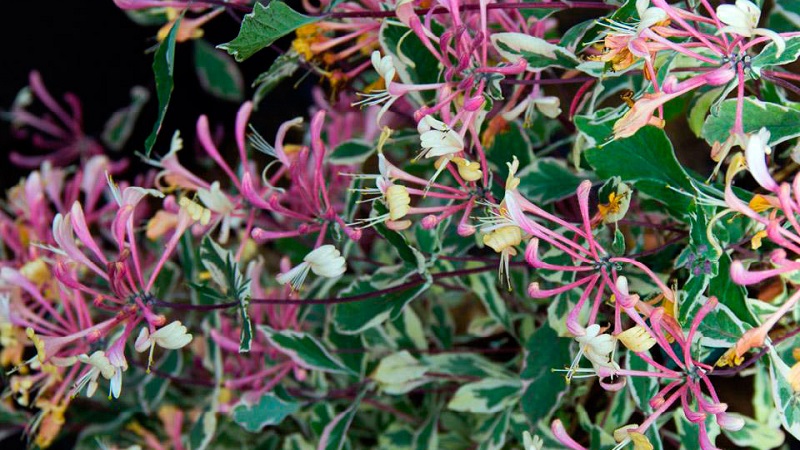
The leaves of this variety are two-colored... They are gray-green in the center and white at the edges. They have a characteristic elliptical shape.
Flowers purple on the outside and white or cream on the inside... Collected in large inflorescences. The berries are red. Vanilla-jasmine aroma, intense.
Like all varieties of Hekrota Variegata, it is distinguished by its demands on moisture and soil composition.... Moreover, it is immune to infections and is rarely affected by pests.
It is interesting! The evergreen variety Variegata originated in Japan.
Features of agricultural technology
Hekrota is somewhat more demanding to care forthan other types of honeysuckle.
Planting process
The culture propagates only in a vegetative way... Only in this case it retains varietal characteristics.
With vegetative propagation use one of three ways:
- Cuttings... This is the most popular method for obtaining a large amount of planting material. Healthy, well-bending branches without signs of disease or damage are cut into pieces 10-15 cm long. Each segment should have at least three live buds. Cuttings are treated with a weak solution of potassium permanganate and a growth stimulant (for example, "Heteroauxin"), after which they are planted in containers with a fertile substrate (peat and sand). The soil is loosened and watered, the soil must always be moist. After the planting material takes root (this is evidenced by the awakened buds), they begin to feed it, for example, "Nitrofoskaya". They are planted in the ground the next year. Cuttings are carried out in early spring.
- Reproduction by layering... With the onset of stable heat, the branches located near the ground are bent to the ground, fixed with a bracket and covered with earth. During the summer, the cuttings are watered and fed. After the branch takes root and shoots, it is separated from the mother plant and divided into parts. They are planted in a permanent place in the fall, before the onset of cold weather.
- Dividing the bush... The root system is carefully dug out, trying to inflict minimum damage on the plant. The bush is divided into parts and planted.
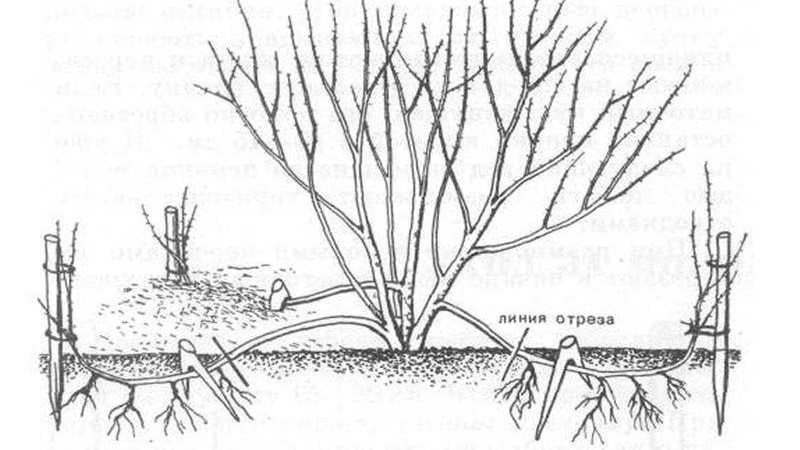
Ready-made seedlings are planted in a permanent place in early spring or in the fall, before the onset of cold weather. So that the plant quickly takes root and does not hurt, it is important to choose the appropriate planting material:
- Root system... Closed or open type. The roots must be moist when cut. It is important that there are no traces of rot and a large number of dry areas.
- Size and age... Preference is given to seedlings 1-2 years old. The height should not be less than 40 cm. Several branches are desirable.
- Escapes... Must be flexible, not dry. If you scrape off the bark with a fingernail, green tissue is found under it. It is important to have at least three live buds on each branch. If you lightly press on them with your finger, they should not fall off.
The planting material should be free from traces of diseases and pests, stains, damage... Flaking is not considered a sign of poor quality. This is a feature of honeysuckle.
Note! Cuttings and seedlings of Hecrota root quickly.
Heckrot is demanding on the composition of the soil... Loose, nutritious, slightly acidic soils are preferred. Groundwater should be located at least 1 m to the surface. It is not recommended to plant honeysuckle near currants and gooseberries.
Before planting honeysuckle in open ground, the soil is dug up and cleaned of weeds... If necessary, reduce its acidity with lime or ash, then watered with a hot solution of copper sulfate.
For Hekrota choose a well-lit, but protected from the wind area of the garden... In the shade, its flowering becomes less abundant.
With honeysuckle planting even a novice gardener can handle it. The main thing is to follow the instructions.:
- Dig a hole with a diameter and depth of 40 cm. The ground removed from it is mixed with 5 kg of humus or rotted manure, 1 kg of ash, 25 g of superphosphate, 20 g of potassium sulfate.
- A 5 cm layer of drainage is poured into the bottom of the hole. A mound is formed from above from a nutritious soil mixture.
- The roots of the seedling are soaked for 2 hours in a light pink solution of potassium permanganate. Then they are soaked for 12 hours in a root stimulator, for example, "Kornevin". In the case of a closed root system, this step is skipped.
- The seedling is placed in the center hole. The roots are evenly distributed around the earthen mound.
- The hole is covered with earth, compacting it. The seedling is watered, consuming at least two buckets of warm settled water.
- If necessary, add more earth. The soil around the honeysuckle is mulched with rotted straw, hay or humus.
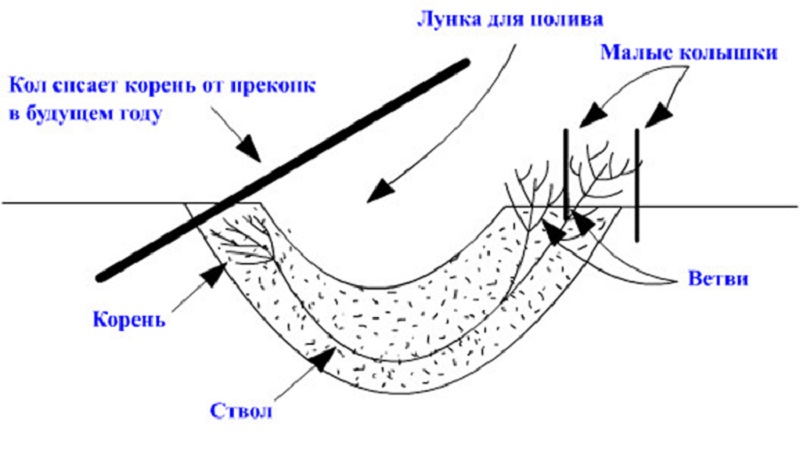
How to care for the decorative honeysuckle of Hekroth
For Hecroth's honeysuckle to develop properly and bloom profusely, it is important to provide it with proper care.... Compared to other varieties of honeysuckle, it is quite demanding.
Note!Hekrota plays an important role in garden design. It is recommended to plant it near fences, gazebos or building facades. She makes these buildings more aesthetic in appearance, braiding them.
Watering and feeding
Heckrot is demanding for watering... With a lack of moisture, its leaves begin to curl, the flowers become small, and the flowering becomes scarce.
In hot dry summers, honeysuckle is watered every day... Water is poured both under the root and the whole plant is sprayed with it. It is better to do this early in the morning or at sunset when the sun is inactive.
For irrigation, use warm, settled water... Cold liquid will cause root rot. If the summer is rainy, the soil is moistened every 2-3 days. Spraying is carried out on all days without precipitation.
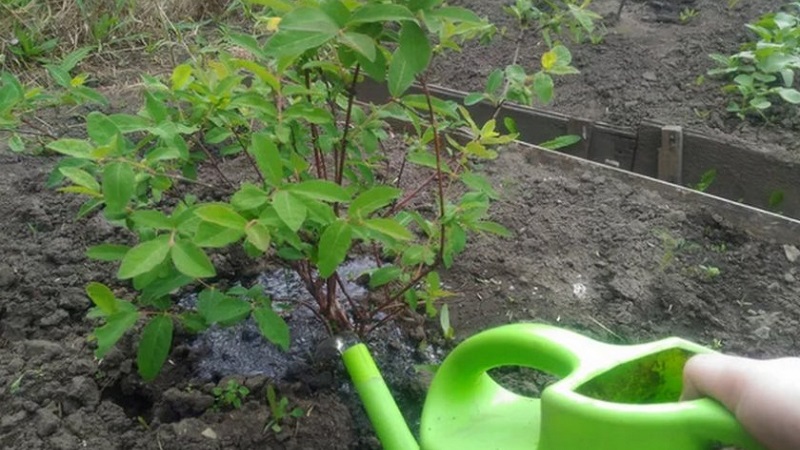
After each watering and precipitation, the soil is loosened, destroying the earthen crust... Otherwise, the water will begin to stagnate and the roots will rot. In the process of loosening, weeds are removed. Weeds often cause bacteria and pests in honeysuckle.
Top dressing begins two years after planting honeysuckle. Before that, the plant has enough nutrients that have been introduced into the soil.
The first top dressing is applied in early spring., immediately after the soil has thawed. The plant is watered with a complex mineral fertilizer or a solution prepared from 30 g of superphosphate. 20 g of potassium fertilizers and 15 g of potassium nitrate.
Before flowering the honeysuckle is watered with Kemira or organic fertilizers. For example, a solution of rotted manure is often used. diluted with water in a ratio of 1:10 with the addition of a glass of ash to a bucket.
In the middle of summer make foliar feeding. The spray mixture is prepared from urea (0.1%), superphosphate (1%), potassium chloride (0.5%).
In the fall, before preparing the plant for winter make 2 tbsp under the bush. ash and 1 kg of rotted manure. Fertilizers are buried under the bush.
Important! The day before applying top dressing, the soil must be moistened.
Pruning and shaping
Honeysuckle care implies regular pruning. There are three types of this procedure.:
- Formative... It is used to give the plant the desired shape. Hecrotus is formed in the form of a bush or liana. Most gardeners choose to keep the five strong stems, removing all the weak ones. If the plant is planted near a support, then its height is adjusted according to the height of the support.Be sure to remove all old branches on which few leaves and inflorescences are formed.
- Sanitary... Held annually. Remove damaged shoots. Branches with traces of disease and pests, cracked bark.
- Anti-aging... It is carried out with a decrease in the abundance of flowering and the formation of a large number of old branches. The plant is shortened by 2-3 cm. All old branches are removed. This stimulates the formation of young growth.
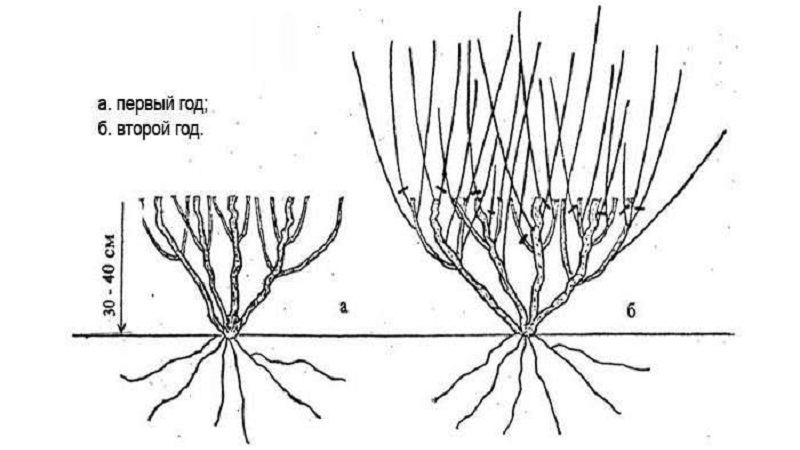
Pruning is carried out in early spring, before the buds wake up or in the fall, before frost... Places of cuts must be treated with garden pitch to prevent gum from flowing out.
Other decorative types of honeysuckle:
Diseases and pests
Honeysuckle Hecroth is immune to most diseasescharacteristic of this culture... Reviews suggest that she is rarely amazed. pests... Despite this, it is important to follow the rules of prevention:
- Pruning... Sanitary pruning is carried out annually and the crown is thinned.
- Correct neighborhood... It is not recommended to plant honeysuckle near currants, gooseberries and conifers.
- Autumn cleaning... In the fall, fallen leaves, broken runs and other plant sediments are removed from the site.
- Disinfection... Be sure to disinfect planting material, soil, garden tools.
Wintering
Despite the fact that Hecroth's honeysuckle is considered a frost-resistant plant, without proper training in northern and central regions she will not survive the winter... To protect the plant from frostbite, it is removed from the support and covered with as high a layer of mulch as possible.
In winter, sprinkle the honeysuckle with snow... If the winter is not snowy, the bush is covered with spunbond.
Conclusion
The description of Hekrota's honeysuckle will delight both experienced and novice gardeners. This is an ornamental plant with beautiful evergreen leaves and large bright inflorescences. It is distinguished by long flowering, during which it exudes a pleasant aroma. Despite the fact that the berries of such honeysuckle are poisonous, they adorn the plant.
Heckrot is more demanding to care for than many other types of honeysuckle. However, following the basic rules of agricultural technology, even a novice gardener can cope with its cultivation.